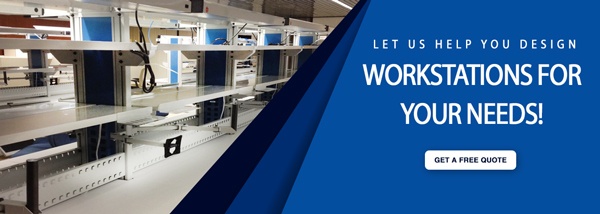Often misunderstood, ergonomics is an important concept in warehouses that prevents injuries and promotes the well being of workers.
Yet some are afraid to explore the benefits that this scientific discipline provides, fearful that it is a bottomless money pit where a return on investment is never realized.
Nothing could be further from the truth.
Research shows companies that embrace ergonomics have healthier and happier workers, and from an investment standpoint, save more money over time.
That’s why more and more warehouse workstations are featuring designs that minimize injuries caused by bending, reaching and other common movements. As a warehouse manager, if you’re not yet convinced why you should embrace ergonomics, here are just a few of the reasons why others are buying in to this important tool in warehouse design.
Design Impacts Injuries
 The design of your warehouse workstation matters not only in how efficient your operations are, but in the everyday movements of your workers.
The design of your warehouse workstation matters not only in how efficient your operations are, but in the everyday movements of your workers.
Think of it this way. When we stand, we are in a neutral position. Any movements that deviate from this move away from a neutral position and can form an awkward posture. These movements include extending or flexing your back, twisting at the waist or bending laterally (or to the side).
In a warehouse workstation, these movements above are common, increasing the risk that awkward movements of the body can cause injury.
In fact, data shows that sprains, strains and tears collectively are the leading type of injury in manufacturing. And while some may consider these injuries to be minor in nature, these injuries can impact time on the job and overall productivity.
Implementing ergonomics in the design of your warehouse workstation promotes natural body positions - they key to reducing workplace injuries of this kind because the workstation is designed to fit the worker rather than forcing the worker’s body to fit to the station.
Statistics Back The Need For Ergonomics
Musculoskeletal injuries are some of the most common among manufacturing workers. These types of disorders or injuries are caused when workers overexert or perform a repetitive motion that cause soft-tissue injuries.
Examples of soft-tissue injuries include:
- Sprains
- Tears
- Hernias
- Carpal tunnel syndrome
- Strains
Some of the most recent statistics released by the U.S. Bureau of Labor Statistics show musculoskeletal injuries accounted for nearly 34% of days away from work (DAFW) in the manufacturing industry in 2017. The reported rate per 10,000 full-time employees was 31.4 cases.
Although that rate was down from the previous year where it was 32.9 cases per 10,000 employees, the number of median days workers missed because of their injuries was still a significant number at 12.
Workplace injuries can have a financial domino effect on several areas of a business. If an injury occurs at work, a company may be responsible for paying the medical bills and time lost for an employee. If legal fees are involved, the process can be even more costly.
Other ways that work area injuries can impact a business include property damage, additional employee compensation and a hit on employee morale.
It’s also important to keep in mind the impact on your company that stems from rising healthcare costs and the cost of claims that may result from an injury. Each year, healthcare costs rise even though one report notes Americans are paying more for similar care levels.
In fact, in 2017, healthcare spending increased 4.2% per person over the previous year. Yet utilization only increased by 0.2%.
Quality Of Workplace Matters
 The happiness of your employees matters and their health and safety directly impact that level of happiness.
The happiness of your employees matters and their health and safety directly impact that level of happiness.
In fact, one study found that there is a direct correlation between a worker’s happiness and his or her productivity. Researchers from the University of Warwick discovered happiness increased productivity by as much as 12%. Workers who considered themselves to be unhappy were 10% less productive.
Workers’ health on the job also impact their happiness and health outside the job as well. Workplace injuries can impact all areas of a person’s life, from finding the time to scheduling doctors’ or therapy appointments to relying on others to help overcome challenges associated with their injuries.
In more severe cases, surgery may be required and workers may require clearance from a physician before returning to work. This can have enormous financial ramifications for an employee since disability payments may not cover all of their salaries or financial obligations.
There’s also one other point to keep in mind as a business owner or warehouse manager. An employee’s level of satisfaction or happiness at work can have a direct impact on how well you are able to retain that employee.
One study found that there is a strong relationship between safety and health and employee retention. Another study by Mental Health America called “Mind the Workplace” found that 81% of employees feel that the stress of their workplace, which can be influenced by a number of factors including safety, impacts their life outside work.
Ergonomics Isn’t One Size Fits All
In fact, it’s very customizable.
Warehouse workstations do not all look the same. Some may focus on packing, while others may focus on building items or receiving and shipping. Some workers may spend a majority of their time sitting, while others find themselves standing and lifting more often.
A company that works with you to customize a workbench or workstation allows you to incorporate ergonomics into a design that meets the needs not only of all of your employees, but all of your employees’ individual needs.
For example, here are a few ways that simple changes can make big differences.
- Ergonomically-designed drawers prevent repeated strains to the body because of their high level of accessibility.
- Ergonomically-adjustable hydraulic benches allow workers to choose whether they want to sit or stand at a workstation by simply using a manual, hand crank or electric control.
- Height-adjustable workstations allow workers to use their bodies’ optimal neutral posture where the body is at its strongest and most efficient position.
- Ergonomically-supportive chairs feature sturdy frames, adjustable heights and comfortable backrests and seats - important for those who sit for long periods of time.
In our article, Maximizing Your Industrial Workbench With Drawers, we further detail some of the features to take into consideration when customizing workstations and incorporating ergonomics in design.
Bottom Line
The proof is in the numbers. Statistics and research have shown that workplace safety and an emphasis on wellness directly impact the productivity of workers and a company’s bottom line.
Industrial furniture manufacturers know the importance of worker safety, which is why more companies are offering ergonomically-designed industrial workstations that emphasize comfort and reduce fatigue and pain from repeated movements and awkward postures.
Our article, Is Ergonomics Important In Lab Design?, further explores the root of ergonomics and how it has become worker safety of the present and future.


